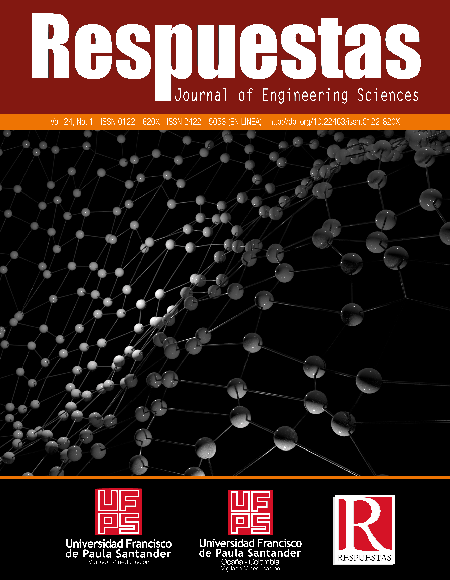Evaluation of SCS - unit hydrograph model to estimate peak flows in watersheds of Norte de Santander
Evaluación del modelo de hidrograma unitario SCS en la determinación de caudales máximos en cuencas de Norte de Santander
Main Article Content
In several studies it is necessary to determine the magnitude of extreme flows in a river. Having an adequate register of observed discharge it is possible to adjust a probability density function (fdp) that allows estimating events associated with a high return period (i.e. 100 years). In ungauged basins, such as the majority of basins in the world are, other methodologies are used, such as the Synthetic Unity Hydrograph proposed by the United State Soil Conservation Service (UH-SCS). The UH-SCS model was evaluated in watersheds of the Norte de Santander department (COL), in its capacity to estimate extreme flows, and to explore its possible regionalization. The evaluation is done by comparing estimates of Q100, using the Frequency Factors method and the UH-SCS model. Discharge and precipitation time series were obtained from the IDEAM network, selecting 19 basins based on their drainage area, climatological stations density and records length. Geomorphology was characterized using ArcMap™ on the ASTER-GDEM digital elevation model. Using information available on geology, soils, vegetation cover, and assuming a wet antecedent moisture condition (AMC-III), values of the median of relative Q100 error (ε-Q100) of + 507% and + 406% were obtained for the fdp Gumbel and Log-Pearson. Using dry antecedent moisture condition (AMC-I) ε-Q100 low to + 36% and + 17%. It was possible to minimize ε-Q100 by calibrating the Curve Number (CN) parameter. A satisfactory regionalization function for CN was not found. Applying SCS-HU under AMC-III condition, Q100 is greatly overestimated. It is possible to minimize the error by considering AMC-I and reduce CN, a counter-intuitive situation since extreme flows are associated with wet weather conditions (i.e. Año Niña). Improvements in the characterization of rainfall and soils in Norte de Santander should be investigated.
Downloads
Article Details
“Leyenda nacional de coberturas de la tierra. Metodología CORINE Land Cover adaptada para Colombia escala 1:100.000”, IDEAM, Instituto de Hidrología y Estudios Ambientales, Bogotá, Colombia, 2010. [En línea]. Disponible en: http://siatac.co/c/document_library/get_file?uuid=a64629ad-2dbe-4e1e-a561-fc16b8037522&groupId=762
Instituto Geográfico Agustín Codazzi (IGAC), Estudio general de suelos y zonificación de tierras: del departamento Norte de Santander. Bogotá D.C.: Instituto Geográfico Agustín Codazzi, 2004.
V. T. Chow, D. R. Maidment y L. W. Mays, Hidrología aplicada. Bogotá D.C.: McGraw-Hill Interamericana S. A., 1994.
J. Ferrer, J. Blanco y J. Ramírez, “Propuesta metodológica para la adaptación del parámetro del número de curva a las nuevas fuentes de datos”, en III Congreso de Ingeniería Civil, Terrorismo y Medio Ambiente, 2006 [En línea]. Disponible en: http://www.ciccp.es/biblio_digital/Icitema_III/congreso/pdf/040205.pdf.
R. Fernández, “Mejora de los parámetros de cálculo del modelo del número de curva y su validación mediante un modelo hidrológico distribuido”, Tesis doctoral, Universidad de Huelva, 2006 [En línea]. Disponible en: http://rabida.uhu.es/dspace/handle/10272/2723
NRCS, “National Engineering Handbook Hydrology Chapters”, 2015 [En línea]. Disponible en: http://www.nrcs.usda.gov/wps/portal/nrcs/detailfull//?cid=stelprdb1043063
R. Vargas y M. Díaz, Curvas sintéticas regionalizadas de intensidad-duración-frecuencia para Colombia. Bogotá D.C.: Universidad de los Andes, 1998.
INVÍAS, “Manual de drenaje para carreteras”, 2009 [En línea]. Disponible en: http://www.invias.gov.co/.
Título D: Sistemas de recolección y evacuación de aguas residuales domésticas y pluviales, Reglamento Técnico del Sector de Agua Potable y Saneamiento Básico - RAS, 2016 [En línea]. Disponible en: http://www.minvivienda.gov.co/Documents/ViceministerioAgua/TITULO_D.pdf
O. Mesa y B. Botero, “Errores detectados al estimar escorrentía directa, mediante algunos métodos de hidrogramas unitarios sintéticos”, Avances en Recursos Hidráulicos, no. 8, pp. 27-38, 2001.
M. Vélez, W. Quintero y J. Delgado, “Implementación del Modelo MG para Antioquia y el Eje Cafetero”, Avances en Recursos Hidráulicos, no. 14, pp. 87-96, 2006.
P. Acosta, y C. Caro, “Regionalización de parámetros hidrológicos. Aplicación para intensidad media de precipitación”, V Congreso Internacional de Ingeniería civil, Universidad Santo Tomás Seccional Tunja, 2014.







